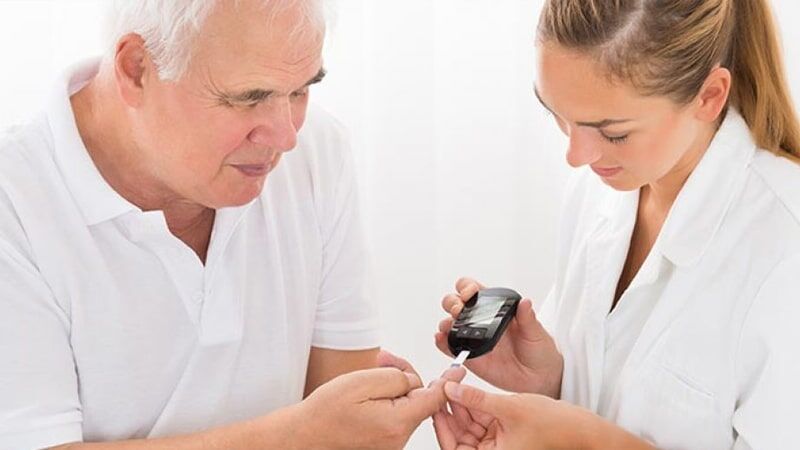I felt sick, powerless, and helpless, like I wasn’t in charge of my life. I felt like I was a victim of this illness and there was nothing I could do.
I spoke to my doctor who said “Keep doing what you’re doing and come see me in a couple of weeks and I will help you “Manage it.” “Can’t you cure it?” “There is no cure but you can manage it” “So I have to do this the rest of my life?” “There are ways to manage it so you can live a normal life, but it will always be there” “Like a person who hasn’t had a drink in 20 years is still an alcoholic?” “You’re thinking about this all wrong Mr Johnstone. That’ll be $50 bucks”.
So I kept pricking myself I hated that machine that would jab that little needle into your fingertip it was painful! You push a button and a little needle slams into your finger. It would hurt, then you would bleed. “It’s just a little blood”… I kept wondering with all the technological advances they brag about, why was I still sticking and jabbing myself, but I could watch Leave it to Beaver on my phone!
Then one day an interesting thing happened… I lost my insurance!
The Facts:
More than 100 million U.S. adults are now living with diabetes or prediabetes, according to a new report released by the Centers for Disease Control and Prevention (CDC). The report finds that as of 2015, 30.3 million Americans population have diabetes. Another 84.1 million have pre-diabetes, a condition that if not treated often leads to type 2 diabetes within five years.
According to the Juvenile Diabetes Research Fund, some 1.25 million Americans are living with T1D, including about 200,000 youth (less than 20 years old) and more than 1 million adults (20 and older).
- 40,000 people are diagnosed each year in the U.S.
- 5 million people in the U.S. are expected to have T1D by 2050, including nearly 600,000 youth.2,3
- In the U.S., there are $14 billion in T1D-associated healthcare expenditures and lost income annually.
The report confirms that the rate of new diabetes diagnoses remains steady. However, the disease continues to represent a growing health problem: Diabetes was the seventh leading cause of death in the U.S. in 2015
Warning Signs
There are diabetes warning signs and symptoms that both women and men have in common like
- Excessive thirst and hunger.
- Frequent urination (from urinary tract infections or kidney problems)
- Weight loss or gain.
- Fatigue.
- Irritability.
- Blurred vision.
- Slow-healing wounds.
- Nausea.
While the CDC is beginning to see diabetes as an epidemic, developing healthy eating habits is a great way to begin to addressing this issue and regaining a normal lifestyle. This is true for both types of diabetes. Eating healthy food can actually help you combat some of the most devastating symptoms of Type 1 or 2 diabetes. It can even help your child with juvenile diabetes. The key is knowing what to eat, and what to avoid when you have diabetes since different foods can raise or lower blood glucose levels. Not knowing which foods do what can make managing your blood glucose levels a bit tricky. Are starches and carbs good or bad? Which drinks should you stay away from? Adapting to a healthy diet tends to lead to a lot of these questions. Let’s go over some of the healthy foods that can help you manage your diabetes. The following healthy dieting advice is just that – advice. It is not an actual diet plan, but it might help you formulate one.
Eating Whole Grains


whole grain? You will have to read the food’s packaging label quite closely. If you see that something has white or enriched wheat flour, it is considered “refined”, which means that there is only a part of the grain. These products just have the starchy bits, so you won’t get the nutrients you need. There are a lot of 100% whole grain products on the market right now. Pastas, breads, and crackers can be made as whole grain. Also, if you see any of these ingredients listed first on an ingredient label, you can bet you’re getting a whole grain product:
- whole wheat flour
- brown rice
- buckwheat (or buckwheat flour)
- miet
- sorghum
- quinoa
Remember, you are going to have to scrutinize these labels. If it says “made with” but doesn’t have a whole grain source listed at the top of its list, the whole food product isn’t actually whole grain. A good rule-of-thumb to go by with regard to cereals is to stick to something that has under 6 grams of sugar per serving and 3 grams of fiber or more per serving.
Dark Leafy Green Vegetables
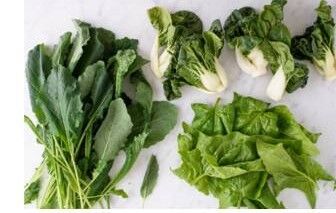
Spinach is a well known health food. It’s packed full of vitamins like B2, B6, folate, copper, magnesium, potassium, and zinc. Past studies have shown that spinach could reduce cancer, cataracts, and heart disease. It’s high in beta-carotene and packed with fiber.
Asparagus is a great choice. It’s a non-starchy vegetable and is packed with fiber. It is low in carbohydrates and high in folate, vitamin C, and glutathione. Glutathione is an antioxidant that can help boost the immune system and promote healthy lungs.
Broccoli Skip the potato side dish and instead fill up on broccoli. It’s full of vitamin C and is packed with fiber. Vitamin C is known to help wound healing. Broccoli is also full of beta-carotene, which is an antioxidant that makes vitamin A. This vitamin helps make healthy eyes, teeth, bones, and skin
Beans and legumes
 Beans and legumes are okay too! These foods have what is called resistant starch, which gets fermented during digestion and turned into short-chain fatty acids. Short-chain fatty acids perform a number of crucial functions. They boost the amount of fat that is available for fuel, helps with weight loss, and lower blood glucose levels. Legumes actually have the most resistant starch, and eating these as part of a balanced diet could help
Beans and legumes are okay too! These foods have what is called resistant starch, which gets fermented during digestion and turned into short-chain fatty acids. Short-chain fatty acids perform a number of crucial functions. They boost the amount of fat that is available for fuel, helps with weight loss, and lower blood glucose levels. Legumes actually have the most resistant starch, and eating these as part of a balanced diet could help
Omega-3 Fatty Acids
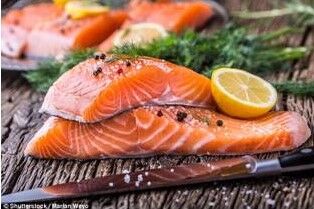 Has anyone ever mentioned getting your omega-3s? These polyunsaturated fatty acids are found aplenty in fish, and they are helpful for combating diabetes. Eating fish twice a week could help you lower bodily inflammation and reduce your risk of developing heart disease, which is a common cause of death for older adults with diabetes. Oily fish, rich in Omega-3 are Salmon, sardines, mackerel, rout
Has anyone ever mentioned getting your omega-3s? These polyunsaturated fatty acids are found aplenty in fish, and they are helpful for combating diabetes. Eating fish twice a week could help you lower bodily inflammation and reduce your risk of developing heart disease, which is a common cause of death for older adults with diabetes. Oily fish, rich in Omega-3 are Salmon, sardines, mackerel, rout
To learn a little bit more about the benefits of omega-3 fatty acids, check out this short video
Nuts and Seeds
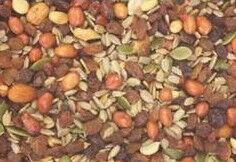
Just remember, if you eat too many nuts and seeds, you might find yourself getting a little bound-up from all the fiber. Again, moderation is key, but nuts and seeds are great for you, and, of course, they’re delicious!
Dairy Do’s and Don’ts


Low-fat, low, or sugar-free yogurt and milk can give you the calcium that your bones and teeth need to stay strong without inundating your system with the things you don’t want. They’re also rich in vitamin D, something that your body needs to metabolize that calcium. Unfortunately, a lot of diabetics tend to have vitamin D deficiency, so boosting your D level is probably going to be important
Foods To Avoid
Sugar-Sweetened Beverages

They’re sweetened fructose, or high fructose corn syrup, which is strongly linked to insulin resistance. Insulin resistance is an impaired response of the body to insulin, resulting in elevated levels of glucose in the blood (a key component of type 2 diabetes and metabolic syndrome) consuming sugar-sweetened beverages may increase the risk of diabetes-related conditions like fatty liver
What’s more, the high fructose levels in sugary drinks may lead to metabolic changes that promote belly fat and potentially harmful cholesterol levels.
Trans Fats

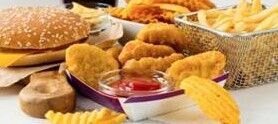
crackers, muffins, and other baked goods to help extend shelf life. Trans fats are unsaturated fats that have been chemically altered to increase their stability. They have been linked to inflammation, insulin resistance, increased belly fat, and heart disease.
White Bread, Pasta and Rice


In another study, replacing white bread with high-fiber bread was shown to significantly reduce blood sugar levels in people with diabetes. In addition, they experienced reductions in cholesterol and blood pressure.
Sweetened Breakfast Cereals

In addition, they provide very little protein, a nutrient that can help you feel full and satisfied while keeping your blood sugar levels stable during the day.
To keep blood sugar and hunger under control, skip the cereal and choose a protein-based low-carb breakfast instead.
There are many more for instance
- Fruit Yogurt
- Flavored Coffee Drinks
- Honey, Agave Nectar, and Maple Syrup
- Dried Fruit
- Fruit
- Packaged Snack Foods
- Fruit Juice
- French Fries
Below is a link to an excellent article by healthline.org which will provide you a more extensive explanation. We have provided a link for you
Conclusion
Diabetes is a chronic disease that has reached epidemic proportions among adults and children worldwide. Uncontrolled diabetes has many serious consequences, including heart disease, kidney disease, blindness, and other complications. Prediabetes has also been linked to these conditions
However, your diet can help you manage and eliminate many of the symptoms and related conditions associated with having this dreadful disease. If you consume the right foods, you could be on the road to recovery from this disease and related conditions. If you continue with unhealthy food choices and eating habits, you will only make yourself even sicker, possibly a disastrous outcome!
Diabetes does not have to be a death sentence. Eating healthy is a huge step in reclaiming your health and well-being. Remember, the food that you put into your body can help or harm you, and a lot of the results depend on moderation. Remain consistent and persist, diabetes warriors! You can do this, and you deserve to feel better.
(continued from opening paragraph)
“So here I am, No insurance! No help! No knowledge of a disease I am told I cannot cure. The feeling of hopelessness was overwhelming. I’m sure we’ve all experienced it at some point in our lives, there is a particular doctor you want to see because everyone says they’re the best, but he or she doesn’t take your insurance so kick rocks.
Soon I ran out of medicine and a bottle of insulin costs about $600.00. I am looking at a potential death sentence. No one to help me “Manage my Illness… not cure it…Manage it” Then I read this book. How to Eat to Live is A great book. The opening line. We must eat to live not live to eat” Wow!
I began thinking this way… If there was something I did to cause this, then there has to be something I can do to fix this. The body is such an amazing creation (Not a Machine, a creation).
So I changed my eating habits! Without knowing a fraction of the information in this article, I began to eat healthier. I thought about animals and how most of the peaceful animals eat plants! Horses, cows, deer, giraffes, elephants, gazelles… all eat plants. So I started eating a lot of green vegetables because plants are green ???? and I started walking. I love walking, not in the city, too crowded. I found a park with a track and I would just walk to the point where I love it now!
I lost over 85 pounds I can resist almost all junk foods on the market. Recently, I got insurance again, after a number of years and I went to the doctor for something completely unrelated. The doctor told me that my diabetes was almost non-existent. No needles, No insulin No pills like Metformin.
I continue to eat as I have trained myself, I continue to walk. I continue to stay in touch with dietritesystem.com You should too…
References www.diabetes.org/food-and-fitness/food/what-can-i-eat/ www.ncbi.nlm.nih.gov/pmc/articles/PMC3977406/ www.diabetesselfmanagement.com/blog/resistant-starch-dont-resist-its-effects/ www.diabetes.org/food-and-fitness/food/what-can-i-eat/making-healthy-food-choices/diabetes-superfoods.html https://www.healthline.com/nutrition/foods-to-avoid-with-diabetes

